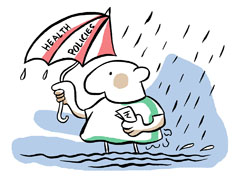Need Expert Advice?Our Gurus Can Help
Dr Shakeeb Ahmed Khan |184 Answers |Ask -Follow
Physiotherapist - Answered on Dec 17, 2025

Dr Shyam Jamalabad |108 Answers |Ask -Follow
Dentist - Answered on Dec 05, 2025

Please be assured, AGE isn't a barrier for implants. But overall health is a factor. Your dentist will assess your bone density, gum health, and general medical history before he places your implants.
Implants have some definite advantages over removable dentures. They provide a stable and secure fit, improved chewing and speech.
And with proper care may last for 10-15 years or more.
On the negative side, upfront cost of implants can be higher, surgery cannot be avoided and healing can take 3-6 months.
Cost-wise, Implants can be more cost-effective in the long run.
"All-on-4" implants might be cheaper than individual implants, but waiting might lead to deterioration of bone health, making the process more complex.
Consult your dentist about:
- Your specific oral health situation
- Bone density scan (to check if you have enough bone for implants)
- Cost estimates and financing options
- Timeline for the procedure.
Dr Shyam Jamalabad |108 Answers |Ask -Follow
Dentist - Answered on Dec 05, 2025

This situation of "2 parallel lines of teeth" arises when permanent teeth erupt BEFORE the deciduous teeth (or milk teeth) have been shed. This indicates a mis-alignment of the permanent teeth. The shedding of milk teeth is dependent on the permanent teeth exerting pressure on them as they grow.
This mis-alignment, indeed, could be the cause of his speech problem.
My advice to you is to consult a competent pediatric dentist or an orthodontist (a dentist who realigns crooked teeth) soon so that corrective measures can be taken.
Dr Shyam Jamalabad |108 Answers |Ask -Follow
Dentist - Answered on Dec 05, 2025

Sorry to hear about your fall and the resultant damage to your teeth.
Honestly, it's best to follow your dentist's advice, but I understand your problem. Eating can be a challenge.
Please ask your dentist about sturdier alternatives like dental crowns or bridges. These can provide extra protection and might let you chew more comfortably.
In the meantime, stick to soft foods which do not put pressure on your compromised teeth, or soups. You can also try cutting your food into smaller pieces to reduce pressure on the tooth.
Dr Shakeeb Ahmed Khan |184 Answers |Ask -Follow
Physiotherapist - Answered on Nov 14, 2025

Dr Shakeeb Ahmed Khan |184 Answers |Ask -Follow
Physiotherapist - Answered on Nov 10, 2025

Please listen to your body's signals and consider consulting a physiotherapist for personalized guidance. I wish you quick recovery
Dr Shakeeb Ahmed Khan |184 Answers |Ask -Follow
Physiotherapist - Answered on Nov 10, 2025

Dr Shakeeb Ahmed Khan |184 Answers |Ask -Follow
Physiotherapist - Answered on Nov 10, 2025

Dr Deepa Suvarna |171 Answers |Ask -Follow
Paediatrician - Answered on Oct 28, 2025

But being overweight is not healthy. It depends on his height and what his weight for height is. Your pediatrician will be able to tell you his weight for height as well as his BMI. Enrolling in a sport helps as also limiting screen time
Komal Jethmalani | Answer |Ask -Follow
Dietician, Diabetes Expert - Answered on Oct 28, 2025

Dr Deepa Suvarna |171 Answers |Ask -Follow
Paediatrician - Answered on Oct 27, 2025

Dr Deepa Suvarna |171 Answers |Ask -Follow
Paediatrician - Answered on Oct 27, 2025

Komal Jethmalani | Answer |Ask -Follow
Dietician, Diabetes Expert - Answered on Oct 22, 2025

Komal Jethmalani | Answer |Ask -Follow
Dietician, Diabetes Expert - Answered on Oct 22, 2025

Komal Jethmalani | Answer |Ask -Follow
Dietician, Diabetes Expert - Answered on Oct 22, 2025

Komal Jethmalani | Answer |Ask -Follow
Dietician, Diabetes Expert - Answered on Oct 22, 2025

Komal Jethmalani | Answer |Ask -Follow
Dietician, Diabetes Expert - Answered on Oct 22, 2025

Komal Jethmalani | Answer |Ask -Follow
Dietician, Diabetes Expert - Answered on Oct 22, 2025

Komal Jethmalani | Answer |Ask -Follow
Dietician, Diabetes Expert - Answered on Oct 22, 2025

Komal Jethmalani | Answer |Ask -Follow
Dietician, Diabetes Expert - Answered on Oct 22, 2025

Komal Jethmalani | Answer |Ask -Follow
Dietician, Diabetes Expert - Answered on Oct 17, 2025

Komal Jethmalani | Answer |Ask -Follow
Dietician, Diabetes Expert - Answered on Oct 17, 2025

Choose whole carbs with brown rice, oats, sweet potatoes, whole wheat breads and add smoothies and shakes. Do resistance training and stay hydrated.
Komal Jethmalani | Answer |Ask -Follow
Dietician, Diabetes Expert - Answered on Oct 17, 2025

Stay hydrated.
Komal Jethmalani | Answer |Ask -Follow
Dietician, Diabetes Expert - Answered on Oct 17, 2025

Komal Jethmalani | Answer |Ask -Follow
Dietician, Diabetes Expert - Answered on Oct 17, 2025

Komal Jethmalani | Answer |Ask -Follow
Dietician, Diabetes Expert - Answered on Oct 17, 2025

Komal Jethmalani | Answer |Ask -Follow
Dietician, Diabetes Expert - Answered on Oct 17, 2025

Komal Jethmalani | Answer |Ask -Follow
Dietician, Diabetes Expert - Answered on Oct 17, 2025

Komal Jethmalani | Answer |Ask -Follow
Dietician, Diabetes Expert - Answered on Oct 17, 2025

Komal Jethmalani | Answer |Ask -Follow
Dietician, Diabetes Expert - Answered on Oct 15, 2025

eggs and fish, citrus fruits, pumpkin seeds and almonds. Foods for weight gain include bananas, mangoes, dates, and raisins, whole grains like oats, brown rice, and millets; healthy fats like ghee, peanut butter, nuts, seeds and protein-rich foods. Foods to reduce premature greying include amla (Indian gooseberry), curry leaves and iron rich foods, etc. Sleep well and exercise regularly.
Komal Jethmalani | Answer |Ask -Follow
Dietician, Diabetes Expert - Answered on Oct 15, 2025

Komal Jethmalani | Answer |Ask -Follow
Dietician, Diabetes Expert - Answered on Oct 15, 2025

Komal Jethmalani | Answer |Ask -Follow
Dietician, Diabetes Expert - Answered on Oct 15, 2025

Komal Jethmalani | Answer |Ask -Follow
Dietician, Diabetes Expert - Answered on Oct 15, 2025

Komal Jethmalani | Answer |Ask -Follow
Dietician, Diabetes Expert - Answered on Oct 15, 2025

Komal Jethmalani | Answer |Ask -Follow
Dietician, Diabetes Expert - Answered on Oct 15, 2025

Komal Jethmalani | Answer |Ask -Follow
Dietician, Diabetes Expert - Answered on Oct 15, 2025

Komal Jethmalani | Answer |Ask -Follow
Dietician, Diabetes Expert - Answered on Oct 15, 2025

Dr Deepa Suvarna |171 Answers |Ask -Follow
Paediatrician - Answered on Oct 08, 2025
Dr Deepa Suvarna |171 Answers |Ask -Follow
Paediatrician - Answered on Oct 03, 2025

Dr Deepa Suvarna |171 Answers |Ask -Follow
Paediatrician - Answered on Sep 21, 2025

Dr Deepa Suvarna |171 Answers |Ask -Follow
Paediatrician - Answered on Sep 21, 2025

Dr Shakeeb Ahmed Khan |184 Answers |Ask -Follow
Physiotherapist - Answered on Sep 19, 2025

Dr Shakeeb Ahmed Khan |184 Answers |Ask -Follow
Physiotherapist - Answered on Sep 09, 2025

Dr Shakeeb Ahmed Khan |184 Answers |Ask -Follow
Physiotherapist - Answered on Sep 09, 2025

Dr Shakeeb Ahmed Khan |184 Answers |Ask -Follow
Physiotherapist - Answered on Sep 09, 2025

Dr Shakeeb Ahmed Khan |184 Answers |Ask -Follow
Physiotherapist - Answered on Sep 09, 2025

Dr Shakeeb Ahmed Khan |184 Answers |Ask -Follow
Physiotherapist - Answered on Sep 09, 2025

Dr Shakeeb Ahmed Khan |184 Answers |Ask -Follow
Physiotherapist - Answered on Sep 09, 2025

Dr Shakeeb Ahmed Khan |184 Answers |Ask -Follow
Physiotherapist - Answered on Sep 09, 2025

Close





























